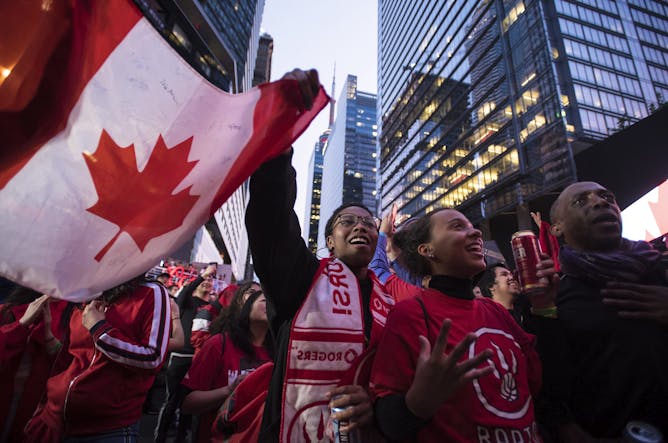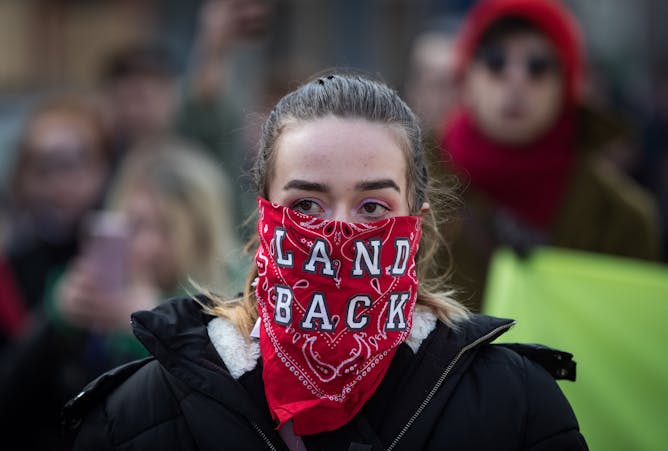|
As we approach Canada Day — and the prospect of a return of “freedom” protests in Ottawa — let’s consider the meaning and symbolism of the Canadian flag.
After the so-called “freedom convoy” occupied Ottawa for weeks this past winter, many of us took a hard look at the symbolism of the Canadian flag and its newfound association with white supremacy. Some, like me, experienced a new fear or anger based on what we feel convoyers are trying to make the flag represent.
Other communities have always felt this way about the Canadian flag.
After unmarked graves were found at the sites of former residential schools, the Canadian flag was flown at half-mast in many places. And last year on Canada Day, there were calls for #CancelCanadaDay and many chose to wear orange instead of red and white.
Other movements like Land Back, Resistance150, Idle No More, Pride and Black Lives Matter have also raised awareness about challenges to Canadian nationalism and belonging.
In today’s episode of, Don’t Call Me Resilient we take a look at the changing meanings of the Canadian flag, multiculturalism, citizenship and what it means to be a settler of colour in Canada. Our guests are Daniel McNeil of Queen’s University and Lucy El-Sherif of the University of Toronto.
Daniel McNeil says “The flag can be many different things. But I think the critical question is to ask, why are those who acknowledge its violence depicted as killjoys or marginalized or stigmatized?”
Two equally interesting articles on Canadian identity were also published today. One that looks at why some people no longer stand for the national anthem and another that asks settler Canadians to think about land back this Canada Day.
Also today:
All the best.
|

|
Vinita Srivastava
Host + Producer, Don't Call Me Resilient | Senior Editor, Culture + Society
|
|

Jubilant sports fans flew the Canadian flag in 2019 after the NBA playoffs. Since then, the ‘freedom convoy’ has used the flag to try to represent their values. Has the symbolism of the flag changed?
THE CANADIAN PRESS/ Tijana Martin
Vinita Srivastava, The Conversation
What does it mean to be a settler of colour in Canada? Has the symbolism of the Canadian flag changed since the Ottawa convoy?
|

Tampa Bay Lightning and Toronto Maple Leafs hockey players stand for the national anthem in Toronto in 2018.
THE CANADIAN PRESS/Frank Gunn
Jason Laurendeau, University of Lethbridge
You can love a country and still hold it to account. I love Canada. But I won’t stand for the anthem at a sporting event or elsewhere, especially not when my kids are watching.
|

A woman wears a bandana over her face reading ‘Land Back’, as people march to block a road used to access to the Port of Vancouver, during a demonstration in support of Wet'suwet'en Nation hereditary chiefs in February 2020.
THE CANADIAN PRESS/Darryl Dyck
Kaitie Jourdeuil, Queen's University, Ontario
Settler Canadians have a responsibility to build respectful, reciprocal relationships with Indigenous nations on our shared geographic space. This relationship starts with land restitution.
|

A spectacular sunset, near Rimouski.
(Shutterstock)
Dominic Lapointe, Université du Québec à Montréal (UQAM)
The tourist appeal of the St. Lawrence River dates to the 19th century. Residents and summer visitors have rubbed shoulders ever since, but not necessarily shared the same ideas about its attractions.
|

Positive representations of higher-weight women exercising can counter the idealization of thin bodies that is common on social media, while cultivating health-promoting exercise behaviour.
(Shutterstock)
Eva Pila, Western University; Madeline Wood, University of Toronto
Social media content that positively represents body size, shape and weight diversity may help to address the negative psychological effects of ‘fitspiration’ that depicts narrow body standards.
|

Humans are not the best judges of consciousness because of their tendency to assign human characteristics on nonhuman entities.
(Shutterstock)
Jordan Richard Schoenherr, Concordia University
A Google engineer’s claims that a chatbot can feel things has prompted people to consider what consciousness means. It also begs the questions of the rights of sentient software and machines.
|
La Conversation Canada
|

Spectaculaire coucher de soleil à Rimouski.
(Shutterstock)
Dominic Lapointe, Université du Québec à Montréal (UQAM)
L’attrait du fleuve Saint-Laurent auprès des touristes remonte au XIXᵉ siècle. Depuis, résidents et estivants se côtoient, mais ne partagent pas nécessairement les mêmes imaginaires.
|
Health
|
-
Lynn T. Kozlowski, University at Buffalo
E-cigarettes are facing calls for complete bans on their sale. A tobacco addiction researcher explores the balance between vaping’s harm to teens and potential use as a tool for quitting smoking.
|
|
Politics
|
-
Rokeshia Renné Ashley, Florida International University
WNBA star Brittney Griner is scheduled to appear in Russian Court on July 1, 2022, after US officials determined she had been wrongfully detained.
|
|
Science + Tech
|
-
Ben Swift, Australian National University
A new AI tool that writes computer code on demand has programmers considering their future.
|
|
|
|
| |
| |
| |
| |
|
|